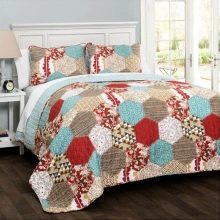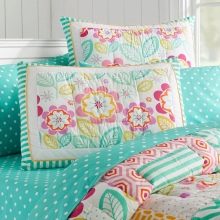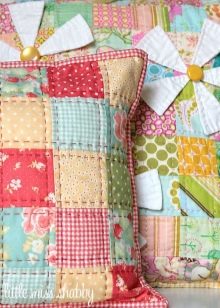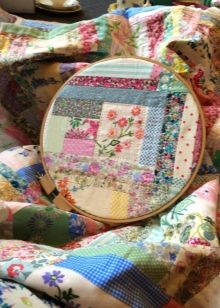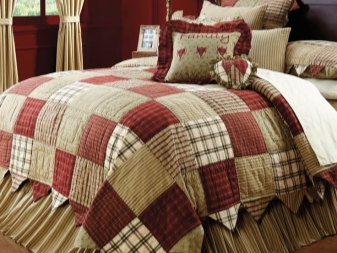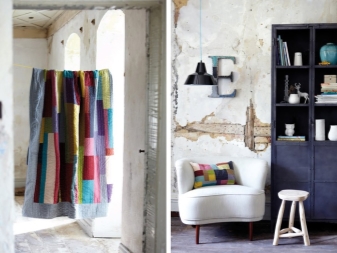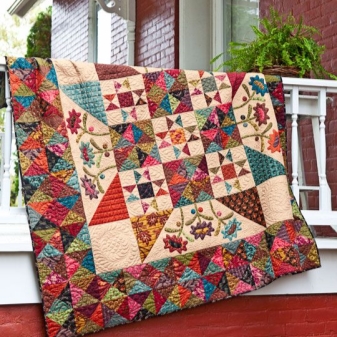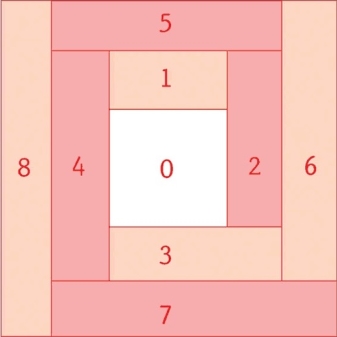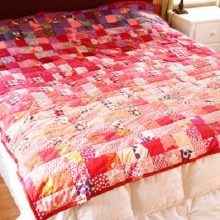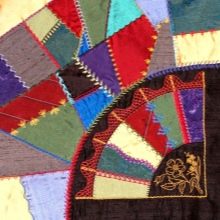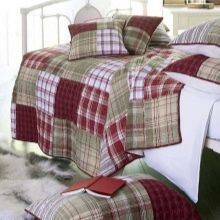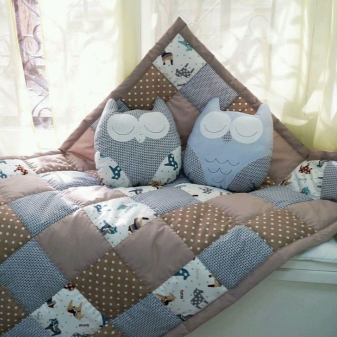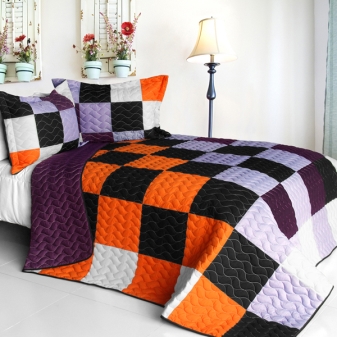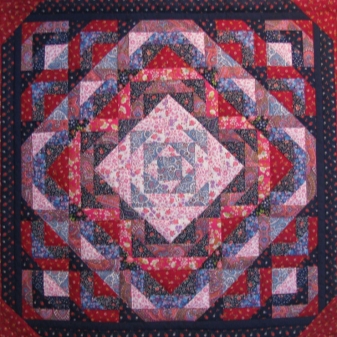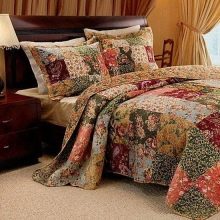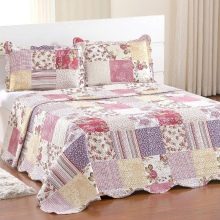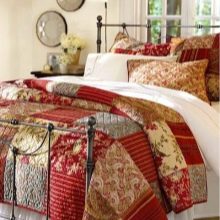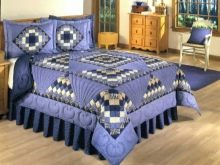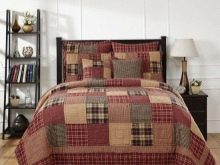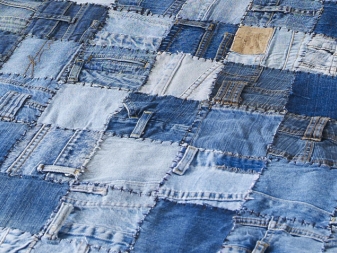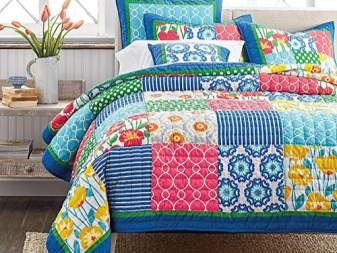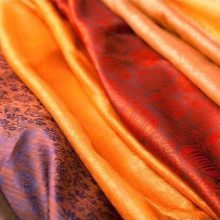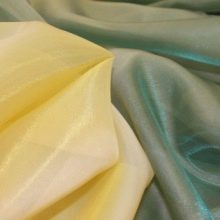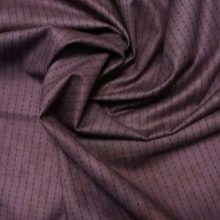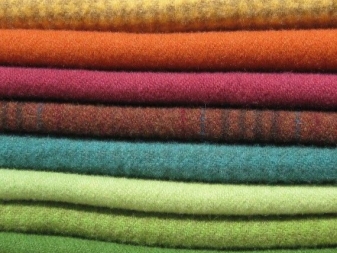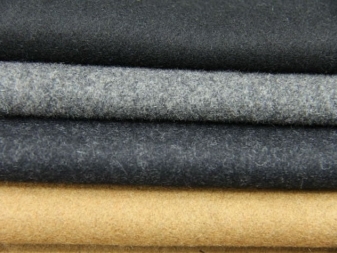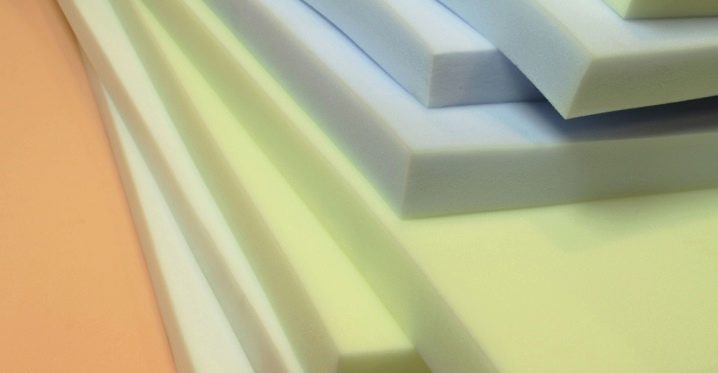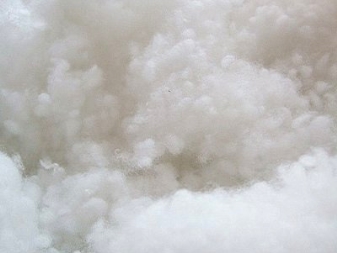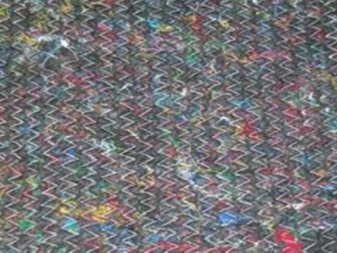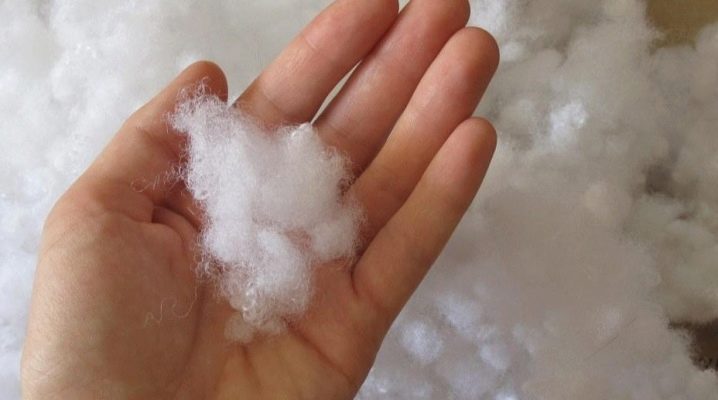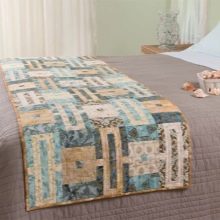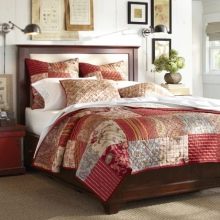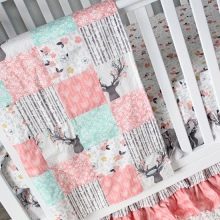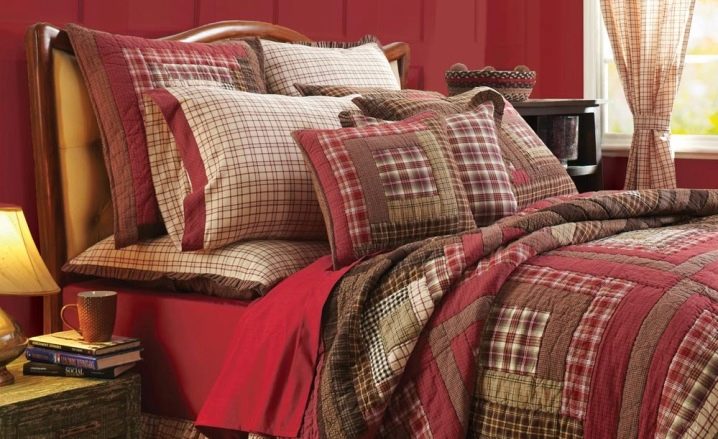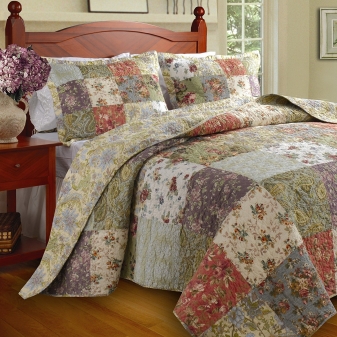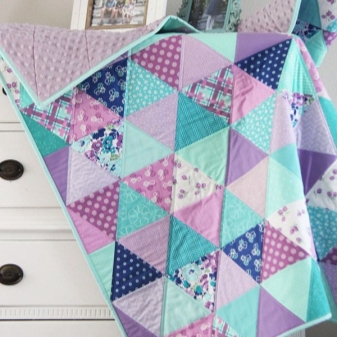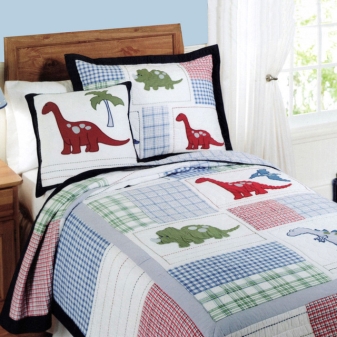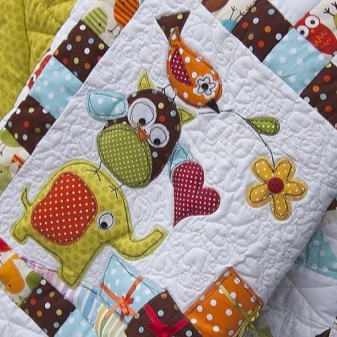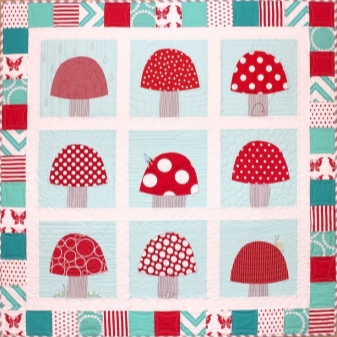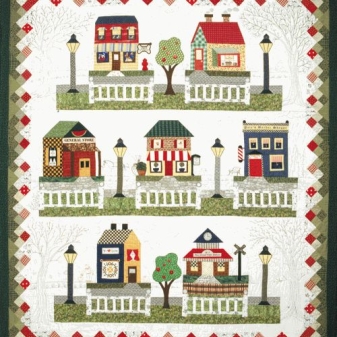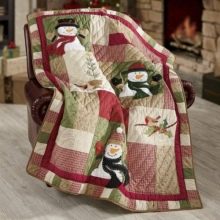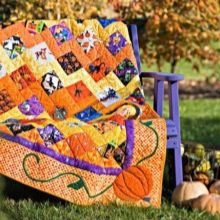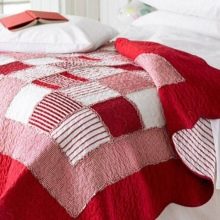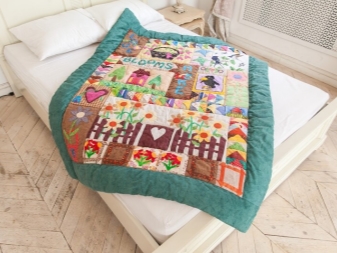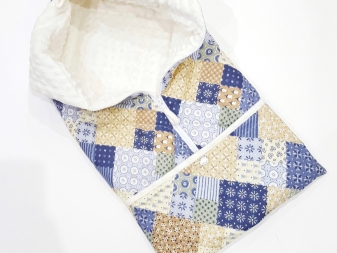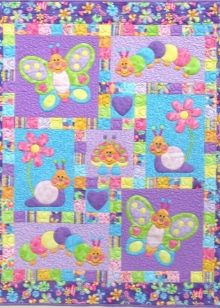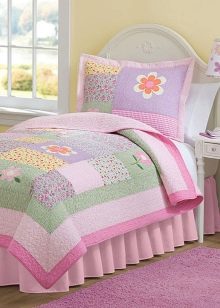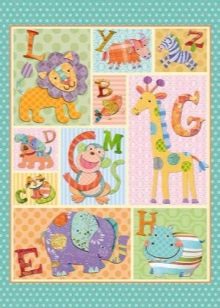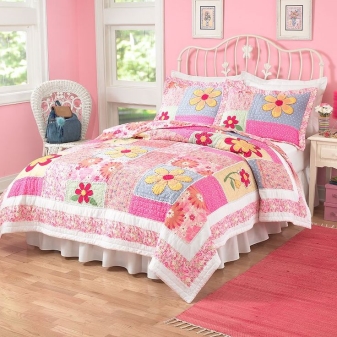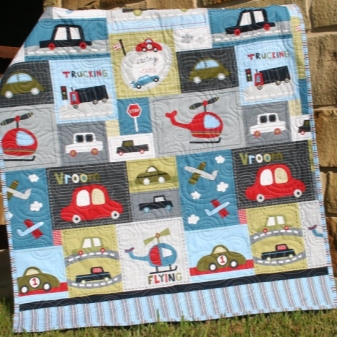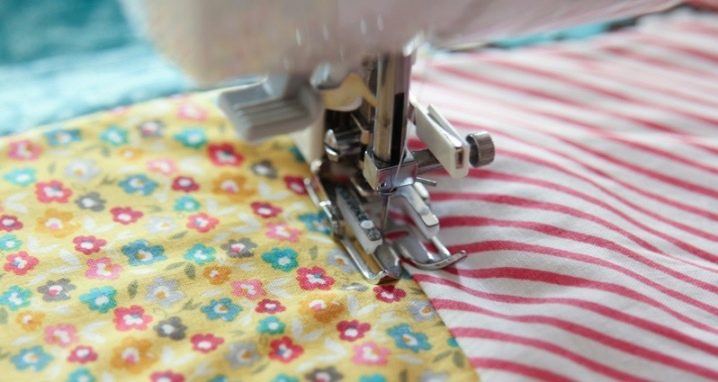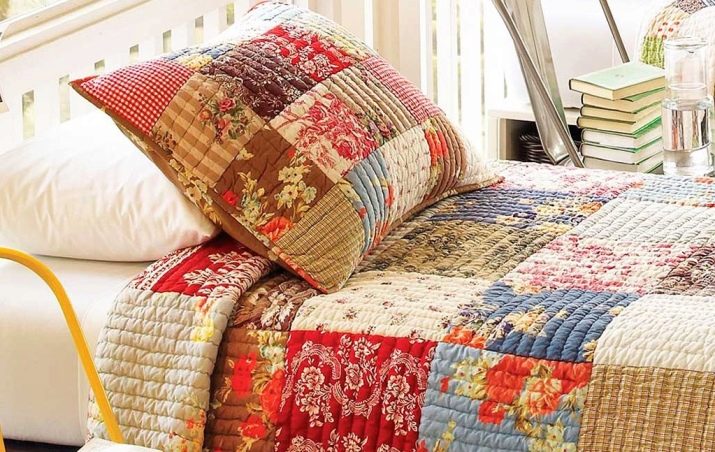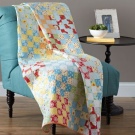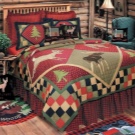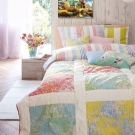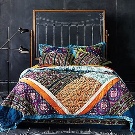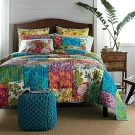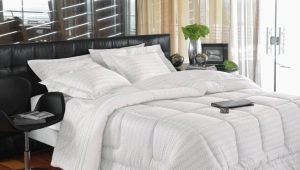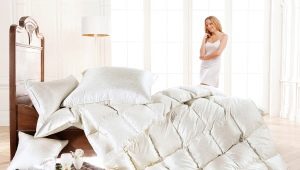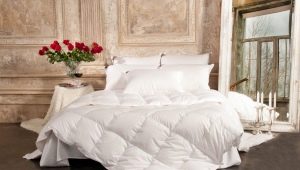Quilts
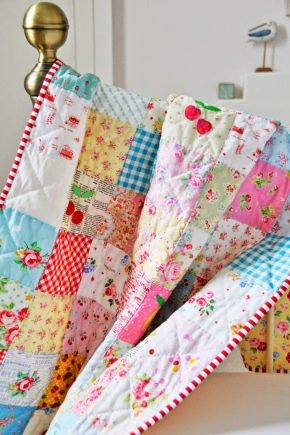
It often happens that we feel sorry for throwing out old clothes that we don’t wear, although it’s not worn out yet, and we don’t want to keep it, because it takes a lot of space. Far-sighted hostesses solve this problem very simply: they let this fabric on a patchwork and make a quilt from it.
Special features
Patchwork is a direction in needlework, within which various things are created from patches and multi-colored scraps of fabric, ranging from small handicrafts and decorative pads to blankets and ottomans. The name of this type of needlework speaks for itself: it comes from the English word “patchwork”, where “patch” is a patch, “work” is work.
The quilt is the most popular patchwork item, especially for beginners and craftsmen.A blanket in this style can have various patterns and ornaments or depict specific objects, it all depends on the technique and the imagination of the master.
It is considered that such types of needlework is an occupation for a single woman in old age and with three cats in her arms, but this opinion is wrong.
Now the patchwork has become a whole stylistic direction, within which professional apartment designers also work. Nevertheless, the best patchwork works belong to amateur masters, who made this hobby their own hobby and breathed life and love into it.
The patchwork culture is so distinctive that it is suitable for the decoration of rooms with completely different interior styles, and not only for rooms in a rustic or country style, as ordinary people think. Quilts and quilts and pillows will harmoniously complement the high-tech and loft designs.
The undoubted advantage of patchwork-style blankets is their availability. They can often be found in stores, and if necessary, sew yourself. The materials are very simple and accessible, they can be found in any home - just look in the closet and sort out old things.The rest of the hostess will help a couple of simple schemes, patchwork technique, a sewing machine and a drop of imagination.
Techniques
The creation of any product in patchwork involves the gradual implementation of the algorithm, which depends on a particular technique. The technique determines which patterns and patterns will need to be used by the master for sewing the product:
- Traditional patchwork - This is the most common technique for creating large products. To begin with, it is necessary to sew a single, whole canvas from a multitude of patches, and then use a pad to form a blanket from it. The pattern of patches is usually located only on the upper part of the future blanket, but there are also bilateral models, where the pattern is located on both sides of the product. In the traditional technique used patches only rectangular or square shape.
A variety of traditional patchwork is the technique of "American square". It also uses rectangular and square forms of fabric, but they are built according to a certain pattern.
- Sometimes the color squares are arranged in rows from dark to light, forming gradient. This technique is called "watercolor".In the framework of this technique are based on pastel colors.
- The next technique is called “Crazy patchwork”, or crazy shreds. The principle of sewing is the same as in the traditional patchwork. The only difference is that this technique uses shreds of completely different shapes and sizes. They can be crooked, small, large, have many corners or not have them at all. Blankets in this technique can be decorated with additional embroidery, ribbons, sequins, buttons, beads, beads, or braid, which are usually placed over the seams to hide them.
- Products created in the technique knitted patchwork, or crocheted patchwork, looks very similar to the traditional technique, if not for one difference. In this kind of patchwork, trimming and patches are not sewn to each other on a typewriter, but manually tied with threads. This is more laborious work. Some housewives create blankets completely made of bonded knitted shreds.
- Blankets in japanese patchwork technique usually quilted, and shreds cut from silk fabric. Figure, in which the flaps are folded, is based on the geometry: rhombus, squares, rectangles and corners.Sometimes the shreds are carved in the form of honeycombs.
- Technique "well" which is also referred to as “log hut”, involves the unification of spirally arranged rectangular patches around the square, which occupies the center of the blanket.
- At the base equipment "chess" are small squares, staggered. Usually when creating such a blanket uses contrasting colors.
- Technique with the name "Russian square" to some extent repeats the national pattern. In the center of the quilt, there are several small squares sewn together, with triangles of different colors adjoining to the sides. Closer to the periphery of the product, squares begin to be used again.
More experienced needlewomen are not limited to the listed techniques and invent their own. Shreds can be combined absolutely in any order, therefore there are no clear laws and prohibitions for this type of needlework. You can create as your heart desires!
For different styles
It is believed that the things in the patchwork are used in simple styles like Provence. However, the interior with accents on textiles from patches can be made not only in rustic, but also in a number of modern styles Loft, Country, Art Deco, Sea or ethno. Patchwork things will not simplify them, but on the contrary, they will soften and become a bright accent giving comfort.
For the townsfolk patchwork is associated with something Russian and simple, but this is a profound error. Pattern patchwork can be built in a mosaic or applique. In addition, patchwork quilts can repeat not only Russian national ornament, but also ethno-patterns of different nations of the world.
Suitable materials
In the patchwork there are no specific settings for the choice of fabric. Initially, this type of needlework was conceived as a way of practical use of old things. Therefore, in one product it is possible to combine fabrics of different textures and shapes - this will only add to its identity. So when creating a blanket of shreds, you can use scraps of any fabric that you like.
Another thing is that not any fabric is malleable to use. Patchwork masters are sure: the best material for a quilt is chintz. This is because it is easier to cut cotton fabric, there will not be threads sticking out on the sides of the chintz patches, it is difficult to put a tightening on such a fabric, it is easy to iron it. Machine stitching on such a fabric will not crawl and come out smooth.
You can choose patches from any old stuff:
- From jeans the most original models turn out. Especially if you take denim of different shades - from light blue to deep blue. You can arrange the pieces in any order, or you can make a gradient of them.
- The combination of patches will help to achieve the original pattern. knitwear or children's things. As a rule, things for children are made of colorful bright fabrics. Often they have a cheerful and unique pattern, and such prints are very suitable for a bright quilt. These are obtained from knitted fabrics.
- A rather bold option is to use materials like silk, organza and staple. These capricious fabrics require a certain skill, therefore it is not recommended to work with them for beginners. However, a seasoned master can create a miracle among them. So, for example, any patchwork will play in a new way, if organza is used as an additional fabric over bright material.
The quilt should be not only beautiful, but also warm. Especially if it is used not as a bedspread, but as a full-fledged blanket.In this case, the material should be warm and pleasant to the touch. These characteristics have wool and drape:
- Maybe, wool not so rich in the choice of color and looks massive, but it is warm and soft. Woolen quilt is usually created for practical purposes - to warm up in the cold, so in cold weather it will be useful. In addition, six easy to operate. It does not crumple and almost does not get dirty, and therefore it will always look well-groomed. The blanket keeps its shape well, and the material itself is very durable and therefore will last for many years.
- Drape can easily replace wool, because it has almost the same features. This material also keeps its shape well, so they can cover any bed, and the blanket will look very neat. The drape wears out for a long time and does not wrinkle. He holds the color for a very long time and does not fade. Finally, the drape is as warm as wool, so it will be indispensable in the cold.
Fillers, insulation
Patchwork can be as thin, more resembling a bedspread, and warmed. It is easy to create a warm blanket - the main thing is to find and sew heating material between the outer and lower patchwork parts of the future product. By the way, there may be several such materials:
- For example, many needlewomen take thinly chopped as the basis loose foam rubber. It keeps its shape well, it does not roll inside the blanket in lumps, elastic and durable. Foam rubber has low wear and tear, so a blanket with such a pad will last longer.
- Sintepon also a good option for stuffing blankets. It is a hypoallergenic resilient material with good heat-saving effect. It retains heat better than foam, which is why it is more often used when sewing winter clothing. Besides things from a synthetic winterizer usually very soft and easy. This material will make the blanket volume, giving it a cozy look. However, it is better to stuff quilts with padding polyester, otherwise the material may roll over time and be distributed unevenly inside the product.
- Sometimes used as a blanket batting. It is a nonwoven fabric made from crushed and compressed scraps of fabric. Batting is considered to be quite warm and pleasant to the touch, but in contrast to the padding polyester and foam rubber, it wears out pretty quickly.
- Another nonwoven material suitable for blanket printing is hollofayber. It appeared not so long ago, but already firmly took its place in the packing of various products. By its appearance and properties, holofiber strongly resembles a synthetic winterizer, although the technologies for their production differ significantly. Holofiber is considered an environmentally safe product for health. It is resistant to washing and various deformations, does not accumulate dust. This material is well breathable, but retains heat. Under a blanket of holofiber, it will not be cold in winter, and in summer it will not be hot.
In some cases, the choice of padding depends on the type of outer material of the blankets. For example, thinner foam rubber or batting would be more suitable for more non-compliant materials such as silk, because they are made in layers, which means they will give shape and thickness to a shapeless product.
Dimensions
The size of any (including patchwork) blankets is determined based on the size of the bed, the parameters of its owner, his activity during sleep and personal preferences.
Thus, the calculation of the dimensional mesh blankets on a single bed will vary from 180-190 cm in length and up to 130 cm in width. For children's beds, the length of the blanket will not exceed 160 cm.
For one and half beds, both large and medium size blankets are suitable. It all depends on the needs of the person. The length of the blanket for the loft also remains in the range of 190-200 cm, while the width varies from 140 to 180 cm. There will be so much space under such a blanket that you can wrap yourself up completely in it.
The specificity of double beds and king size beds are their huge dimensions. A good solution for such beds would be a voluminous quilt that is much larger than standard sizes. The length of such blankets can reach 200 cm or more, and the width - from 2 to 4 meters.
There are non-standard sizes of beds, a blanket for which can reach 5 meters. However, these models are relatively few, so bed linen and blankets for them are usually made to order.
Colors and patterns
The traditional, and at the same time, the most common pattern for patchwork in the patchwork style is geometry. Typically, classic patchwork patterns fall into two categories:
- Products from squares. The square is the primary element, which is often the center of the composition.Even the simplest cover made only of square shreds will decorate any bed space.
- From triangles. The triangular pattern on the quilt looks smaller and more variegated than the square one. More often colored triangles are composed in such an order that they form a square. It will look great on any quilt pattern, based on the alternation of figures.
Various schemes of ordinary squares, rectangles, rhombuses, triangles and polygonal shapes are very popular, but there are other designs for patchwork quilts.
Patchwork does not limit the masters in choosing a pattern. In addition to the usual geometry, you can create entire applications of fabric. For example, you can place on the blanket images of the characters of your favorite books and films. For children's blankets, you can use images of any cartoon characters. The child will love this creative canvas.
A patchwork cover created in the form of a mosaic or a collage with photos will be a good gift. Such a blanket will surely cheer up its owner, because the dear to the heart will always be in front of your eyes.
To create a quilt you can creatively approach and make it thematic. For example, in the application, you can use New Year or Christmas motifs, depicting an elegant Christmas tree with an asterisk on the top. You can also coincide with the theme of the canvas for your birthday or Valentine's Day. You can dream up on Halloween or Easter. If desired, any idea can be embodied in a patchwork.
There are no rules about the color palette: you can use any shades of any color. It can be motley synthetic patches with different prints and colors, or it can be monochromatic trimmings in pastel colors.
Monochromatic and variegated fabrics can be alternated with each other, so the overall look of the blanket will become even more distinctive.
Baby
Quilts for children are made on the same principle as for adults. Only sizes will differ: for children's bedrooms, blankets up to 140 cm in length and up to 100 cm in width are chosen. For teens sizes will be bigger.
In the patchwork you can make blankets for newborns and small children up to 2 years old. The envelopes made of shreds on an extract will look beautiful. Such products always look very cute.
Blankets for children should be made of high-quality and soft materials that will be pleasant for delicate baby skin and will ensure a comfortable sleep for your child. You should not choose a product from prickly and rigid material.
Things for children from five years old are usually made colorful and attractive. Therefore, it is quite possible to use a bright application with a picture of a favorite toy of a child or a cartoon character for a quilt. Details of the picture is best done as large as possible.
For very young kids, calm and soft shades that do not irritate the eyes are suitable.
Remember, the child should be comfortable sleeping under a blanket:
- For girl You can use pink, red and purple tones. On a blanket there can be an image of a favorite doll or a bear, this is exactly what a little princess will like. Styling the nursery, you can choose one print for all the textiles in the room: for curtains, bedding and upholstery of upholstered furniture or children's chairs. Patchwork is also suitable for creating attributes for toys. For example, you can create a patchwork blanket for a doll that would repeat the pattern of the girl’s blanket.
- For boys colors will be blue and green shades.The pattern of the bedspread and pillows can depict what the boys are interested in: they can be products with various super-heroes, cars, helicopters and ships.
How to become the owner?
Handmade quilt can be bought, but you can make yourself. In many stores for needlewomen there are ready-made patchwork kits containing templates and other necessary things.
Making a blanket does not take much time. First you need to draw a sketch of the product. It will be in the form of a diagram. Then, based on the scheme, it is necessary to cut out the details of one form or another from the selected material. After that, pieces of fabric must be sewn together, thereby collecting the front part of the blanket. If you plan to sew a double-sided blanket, you will need twice as many shreds.
When the upper and lower parts of the blanket are ready, it is necessary to process their edges and then stitch together by adding a filler. Leaving the raw edges is not worth it - such a product will look careless. When connecting the edges of the upper and lower parts of the blanket, the bake is usually used as a border.
Usually quilts need to be quilted so that the filler is always evenly distributed and does not go astray.
Options in the interior
Patchwork blankets can be combined with pillows in the same style - such sets always look harmonious. Here are a few ideas for interiors using patchwork.
How to sew a quilt in 30 minutes, see the next master class.
